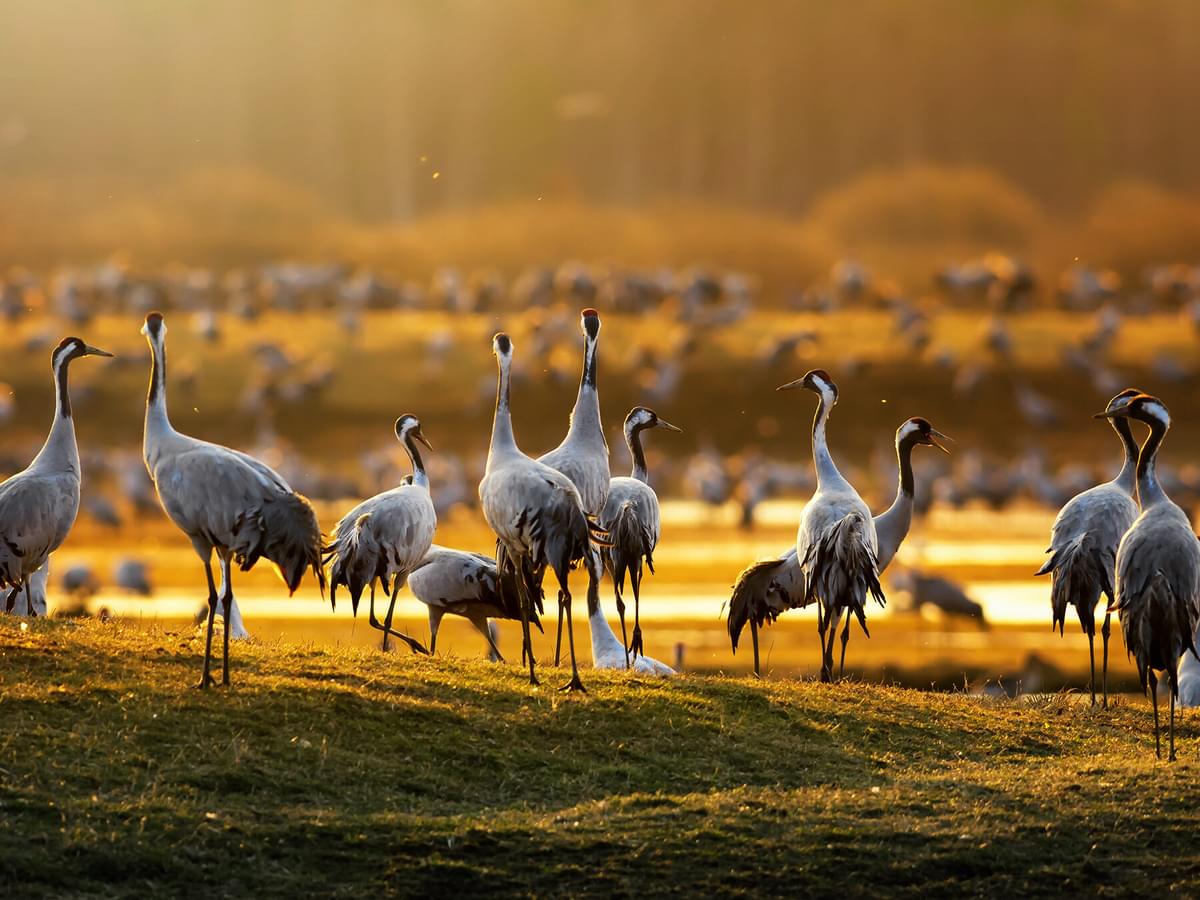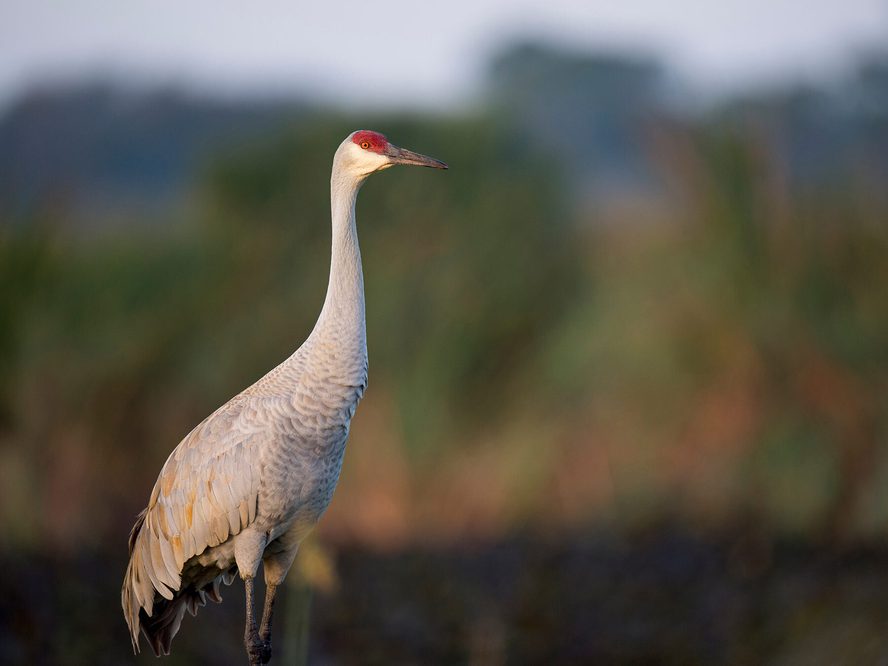Jump to Section
What Is A Group Of Cranes Called? (Complete Guide)
Last updated: 29 May 2022

Cranes are distinctively long-legged and long-necked birds from the Gruidae family of the Order Gruiformes.
There are only 15 species of cranes distributed across three genera, but they have a wide distribution and live on every continent except South America and Antarctica. Cranes are generally gregarious birds that live socially throughout much of the year, so what is a group of cranes called?
The most common collective noun for a group of cranes is a flock, which is a generic term for most groups of birds. While cranes are very gregarious in the winter and during migration, they isolate themselves from others during the breeding season and often become territorial. This isn’t unusual amongst birds.
Cranes are adaptable birds that live in practically every habitat imaginable. For example, the Siberian crane lives in the Siberian tundra and Subarctic, whereas several cranes live throughout South Asia and South Africa, such as the Grey Crowned crane, Sarus crane, Wattled crane, and the Blue crane.
Read on to learn more about the social lives of these tall and handsome birds!

A flock of Sandhill Cranes
Other terms for a group of cranes
- A construction of cranes
- A brood of cranelings (baby cranes)
- A dance of cranes
- A family of cranes
- A flock of cranes
- A herd of cranes
- A pair of cranes
- A sedge of cranes
- A siege of cranes
- A sledge of cranes
- A swoop of cranes
- A thumping of cranes
- A wedge of cranes
- A trumpeting of cranes
- A kettle of Sandhill cranes
One of the most amusing terms for a group of cranes here is a construction of cranes! Cranes are often migratory, hence why there are terms that refer to migrating cranes, such as a wedge and a kettle.
Do cranes flock together in groups?
Most species of cranes form flocks at some point in the year, primarily for wintering and migration.
For example, the Sandhill cranes of North America migrate in their thousands, forming massive flocks of many birds in the southern states and Central America. Bosque del Apache National Wildlife Refuge, near Albuquerque, New Mexico, hosts huge flocks of wintering cranes. There’s even an annual Sandhill Crane Festival!
In Europe, the Common crane migrates from much of northern Europe and North Asia to Africa, the Middle East, India, and Southeast Asia. Wintering flocks are massive, featuring hundreds or thousands of cranes. However, in the case of the Sarus crane, paired cranes maintain their territories throughout most of the year, and it’s only unpaired adults that form flocks.
Breeding cranes isolate themselves and become markedly less sociable in the spring and summer, though the birds often gather in small flocks to feed. However, non-breeding juveniles and adults remain gregarious and form “summering flocks.”

A group of migrating cranes in flight together
Why do cranes flock together in large groups?
Cranes form flocks for safety in numbers and because their typical habitats and food sources are relatively confined. Many waterbirds are gregarious for this reason - they’re confined to habitats with water sources such as marshes, pools, river estuaries, deltas, lakes, rivers, and coastlines.
Cranes often forage and migrate together in what are called “survival groups”. Cranes are large birds that are targeted by some fierce land predators, and given that they spend much of their time foraging on dry land, these groups are necessary for their survival.
When do cranes flock together in groups?
Cranes flock together during migration and throughout the winter. However, not all cranes migrate, and those that don’t, like the Sarus cranes, tend to maintain their breeding territories all year round.
At the start of migration, cranes convene in flocks formed of multiple family groups. The previous year’s chicks accompany their parents. Some cranes migrate colossal distances - the Lesser Sandhill crane can undertake a roundtrip of some 22,530 km (14,000 miles)!
Once they reach their wintering grounds, cranes remain gregarious. Some wintering flocks consist of thousands of birds. Adults and juveniles mingle with few issues, foraging and roosting together at night.

A small flock of wintering Lesser Sandhill Cranes
How many cranes are in a flock?
During migration, crane flocks typically consist of several family groups, numbering 20 to 50 birds. Some flocks are much larger, consisting of around 500 to 1,000 birds or so.
The flocks formed just prior to migration are the most massive. For example, around 600,000 Sandhill cranes gather at Nebraska’s Central Platte River Valley each spring prior to migrating - one of the world’s oldest and grandest migratory journeys. Researchers believe cranes have been making this journey for over 10,000 years.
Do crane families stay together?
Crane families stay together for much of the year following the breeding season. Crane chicks remain under close care and supervision of their parents for the entire summer, and usually undertake their very first migration with their parents.
Once the family unit returns to its breeding grounds, the 10-month-old juveniles will form a non-breeding flock until they reach sexual maturity at 3 to 7-years-old.
Cranes are long-lived birds with slow lifecycles. Some species of crane regularly live for over 30 years in the wild. Throughout Asia, these birds symbolize longevity, immortality, and eternal youth.

Sandhill Crane family on an evening stroll
Do all cranes flock together?
Virtually all species of cranes are capable of gregarious behavior. However, some of the non-migratory species, such as the Sarus crane, are more territorial than others and maintain their breeding territories throughout the year.
In this case, only the non-breeding juveniles and adults form gregarious flocks. In other words, cranes very rarely form flocks if they’re breeding and raising young chicks.
What is a pair of cranes called?
There’s no specific name for a pair of cranes. Cranes form life-long monogamous bonds with their mates and polygamy or polyamory is rare.
Moreover, studies show that cranes often choose partners that they socialize with during their youth - sometimes described as their “childhood sweethearts”.
Cranes are known for their elaborate and beautiful courtship dances, which some species renew periodically.

A pair of Sarus Cranes in a paddy field
Do cranes fly in groups?
Cranes usually migrate in medium-to-large flocks. In some cases, these migratory flocks consist of thousands of birds, but they typically number less than 100 birds.
Prior to migration, some species of cranes gather in their thousands. Then, they form flocks and take off in stages in a well-regimented steady stream of birds.
On this page
- Other terms for a group of cranes
- Do cranes flock together in groups?
- Why do cranes flock together in large groups?
- When do cranes flock together in groups?
- How many cranes are in a flock?
- Do crane families stay together?
- Do all cranes flock together?
- What is a pair of cranes called?
- Do cranes fly in groups?



